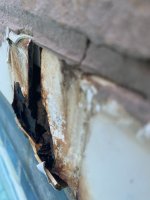Orion7319
Bronze Supporter
- Jul 1, 2020
- 1,442
- Pool Size
- 19775
- Surface
- Vinyl
- Chlorine
- Salt Water Generator
- SWG Type
- Hayward Aqua Rite (T-15)
The track is where the liner gets tucked in as it’s what hangs the liner. Last year I had to replace our liner as well as the fiberglass steps because they were busted. We replaced the steps with plastic steps that were more of an oval shape that better matched the oval shape of the pool. They had to alter the radius of the pool coping in that area and added new coping pieces and were able to tie it in. Point is that you should ask the company that is changing out the liner about it. They can probably fix it if they can find that exact coping.This is where I’m confused. My coping does not have a track under that I can see. See photo please


